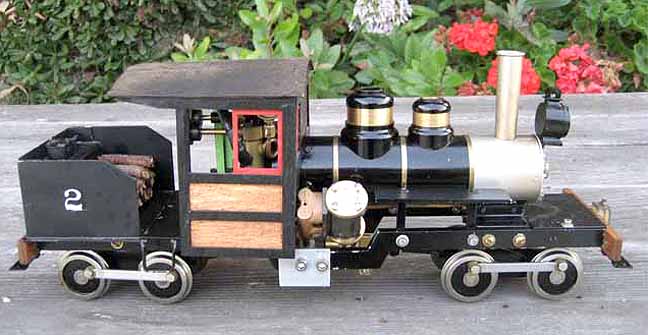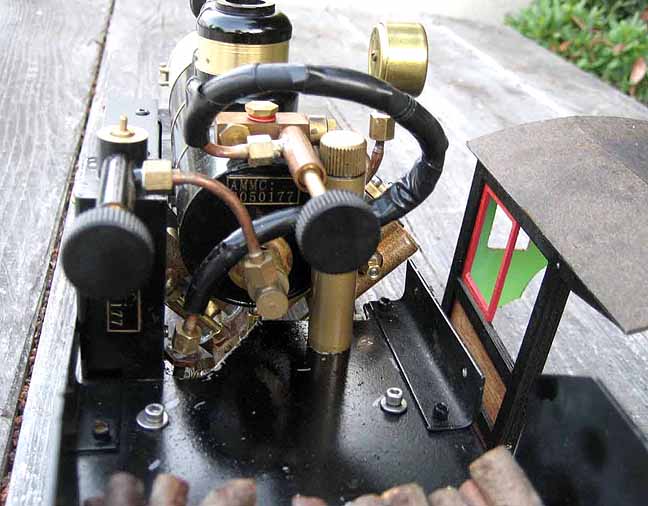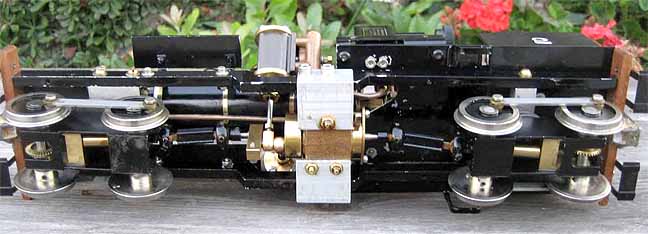Back to Sidestreet Bannerworks
Click here to find out how your engine can be featured!
.


A home-built Heisler
by Sean Tower
Rochester Hills, Michigan
Photos by the author
July, 2011
The Heisler locomotive was first developed by Charles L. Heisler late in the 19th century to tackle the sharp turns and steep grades found on logging lines.
A V-twin steam engine transferrs power to the far front and far rear axles via a central drive shaft. The shaft is articulated with telescoping universal joints. Gears are bevel gears. The wheels toward the middle of the engine are powered by side rods.
Model history
This locomotive took about two years to build, working off and on in the University of California Santa Barbara mechanical-engineering machine shop.
The boiler and most of its fittings came off an Accucraft Ruby. The V-twin oscillating engine came from The Steam Chest, an eBay company. Trucks and frame are scratchbuilt.
I originally designed and built my own V-twin for the model, based on a set of double-acting oscillating cylinders from a Mamod locomotive. It worked well on compressed air but not at all on steam, when installed in the locomotive. I determined that, because I had decided to place the reversing valve in the cab (for which an extensive amount of plumbing was required, routing steam back and forth), the steam was too cold to provide the energy required by the time it got to the cylinders.
The current V-twin engine I purchased and modified does not have this problem, as the reversing valve is self-contained in the engine and requires minimal plumbing. That said, at 1/2", the cylinder bore is much larger than I would have wanted for the project and I fear that this adversely affects performance, given the low volume output of the Ruby boiler. Currently, the engine can only pull a very light and short train.
There are a few ideas floating around in my head as to how to improve this problem but, as I am currently (temporarily) working in Michigan, I am separated from the engine (and most of my things). Also, I am constantly coming up with new projects, so any improvements may never happen.
One interesting note is that, because the V-twin engine was intended for marine use, the reversing valve is inconveniently wrapped around the driveshaft, with its lever pointing down, making it almost unreachable. Mostly, I just set it and forget it. I don’t really see the need to add a linkage to the cab.
The run
After oiling all around and filling the boiler and gas tank with distilled water and butane, respectively, I lit the fire. After waiting for the pressure to rise to 60psi, I opened the throttle to clear the condensate from the steam lines and cylinders. After waiting for pressure to rise again to about 40psi, I again opened the throttle and the locomotive came to life. The run lasted about 20 minutes but, because of the Goodall-type filler valve, could have lasted indefinitely.
Here's a video of the Heisler running on rollers. If, for some reason, you can't view it, click here.
|
|
|
| Builder | Sean Tower (USA) |
| Date completed | 2010 |
| Gauge | 45 mm (gauge 1) |
| Scale | 1:24 (approximately) |
| Boiler | Single flue |
| Fittings | Safety valve, throttle, pressure gauge, Goodall-type filler valve |
| Fuel | Butane |
| Blow-off pressure | 70 psi |
| Cylinders | Two double-acting oscillators |
| Reversing gear | Rotary valve |
| Lubricator | Displacement |




Back to Sidestreet Bannerworks
Click here to find out how your engine can be featured!
This page and its contents
Copyright Sidestreet Bannerworks, 2011